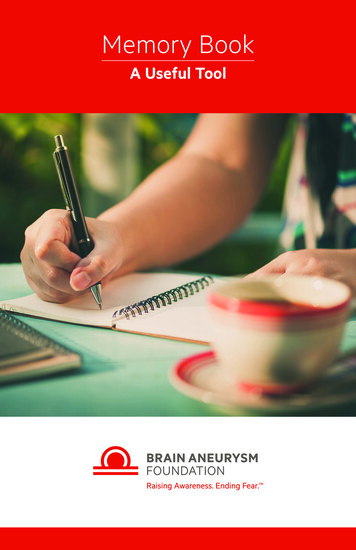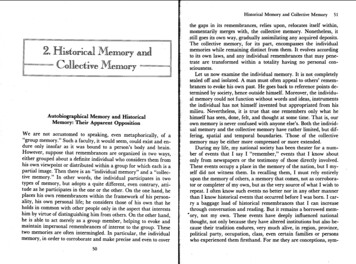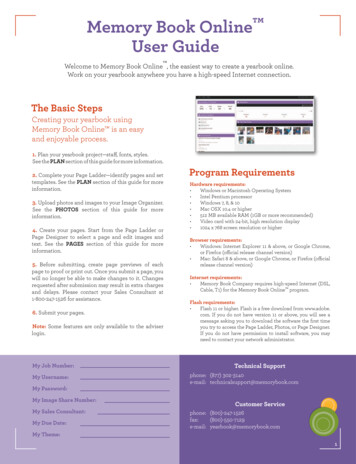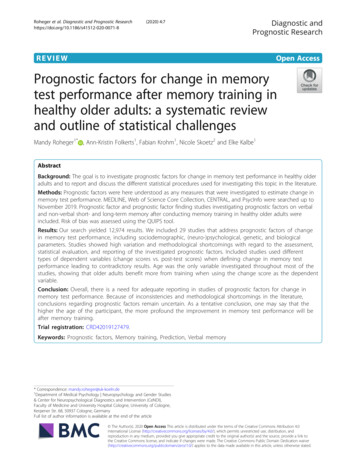
Transcription
Memory BookA Useful Tool
OUR MISSIONProvide information about and raise awareness of thesymptoms and risk factors of brain aneurysms toprevent ruptures and subsequent death and disability.Work with medical communitiesto provide support networks for patients and families.Advance research to improve patients’ outcomesand save lives.11
Most survivors have memory problems and many cannotremember to do things during the day. If possible, consultationwith an outpatient speech therapist to evaluate and treatcognitive deficits is beneficial. Your nurse who works with yourneurosurgeon or neurologist can help you obtain this evaluation.Survivors with memory problems often benefit from learning touse a memory book. This useful tool is based on the principlethat practice produces new habits over time.2
Imagine a survivor who has returned home following a ruptured aneurysm andseveral weeks of living in a rehabilitation facility. She has recovered enough to stayat home during the day while her husband goes to work, but gets little accomplishedwhile he is gone. She has trouble getting organized and gets distracted if she tries todo too many things at once. It is not unusual for her husband to return home fromwork and find the wet laundry still in the machine because she did not remember tomove the clothes to the dryer. She has trouble taking her noon dose of medicationsand on a few occasions has taken it twice.If her husband is uninformed about why this is happening, he might becomefrustrated and angry because his wife “just doesn’t try,” or “just wants me to do it all.”After returning home to disorder, he might speak harshly to her, suggesting thatshe is not working at recovery or that she is “lazy.” Hearing these words, she mightconclude that he is correct and that she is worthless. As neither understands why sheis having these problems, no solution emerges, and frustrations and distress build.3
Contrast the uninformed husband to one who knows that his wife’s disorganizationand poor memory are the result of the aneurysm and who has some ideas abouthow to teach her to use a memory book to help her carry out various tasks while heis gone during the day.The informed husband first shifts his explanation from an emotional one (“shejust isn’t trying”) to a behavioral one (“she can’t remember to do what she hasplanned”). He shifts his ideas about why she is making these mistakes from ablaming attitude (“she’s doing this on purpose”) to an informed attitude (“she hasmemory problems because of damage to her brain from the aneurysm rupture”).Armed with information, the husband is better able to design a treatment planthat will help his wife learn how to spend her time at home in a more productive,safer, more satisfying way. He is less frustrated, less harsh, and more forgiving ofher errors. The survivor, encouraged instead of criticized, makes a better effort, andfeels more positive in the process.With a basic understanding of behavior principles, the husband can design a planto systematically teach his wife to use a memory book. First, he needs to analyzethe problem. Simply giving her a list of things to do will not be effective, as she willforget to consult the list during the day. The husband must help his wife build anew habit of looking at the memory book frequently throughout the day and usinglists in the book to organize what she wants to accomplish while he is away at work.The treatment plan used by the husband or other caregiver to encourage thedevelopment of future memory skills with a memory book is based on the principlethat practice produces results. Once the habit is established, the survivor isincreasingly capable of planning and following through on her plans without help.The plan starts with active involvement from the husband, and as the wife practicesthe skill, it turns into a habit. This process is repeated with new tasks to learn untilthe recovery process is complete.In this case, the key skill learned by the wife is to consult her memory book onan hourly basis and to follow the plans she and her husband established the daybefore. By using cues to prompt repetitive practice, the husband helps his wifelearn to use a list to accomplish her goals for the day.4
There are many systems that have been designed to assist memory–impairedpeople remember to do what they have planned. Below is a simple template forlearning to use a memory book.1. Plan the next day and write down goals.2. Break the day into one- to two-hour segments.3. Write goals for each segment. 10:00 a.m. “Put laundry in washing machine and start” 11:00 a.m. “Take laundry from washing machine and place in dryer” 12:00 p.m. “Take laundry from dryer, sort and fold”4. S et a watch or smartphone timer to beep at two-hour intervals. It is helpfulfor the caregiver to call every two hours to make sure the memory book isavailable and was consulted at the right time.5. At each time interval, the survivor records the activities for the previous hourand carries out the tasks designated for the next hour.6. A t the end of the day, the caregiver and survivor review the day’s progress.Adjustments are made until the survivor can follow the schedule independently.In our example, phone calls and the beeping watch or smartphone would not beneeded after the habit of using the book is established. The need or ability of asurvivor to use these suggestions depend on the extent of impairment as wellas the degree of support that is available.5
For more information, visit us at: bafound.orgCONNECT WITH ndinstagram.com/bafoundCONTACT USBrain Aneurysm Foundation269 Hanover Street, Building 3 Hanover, MA 02339(888) 272-4602 (781) 826-5556
new habit of looking at the memory book frequently throughout the day and using lists in the book to organize what she wants to accomplish while he is away at work. The treatment plan used by the husband or other caregiver to encourage the development of future m










